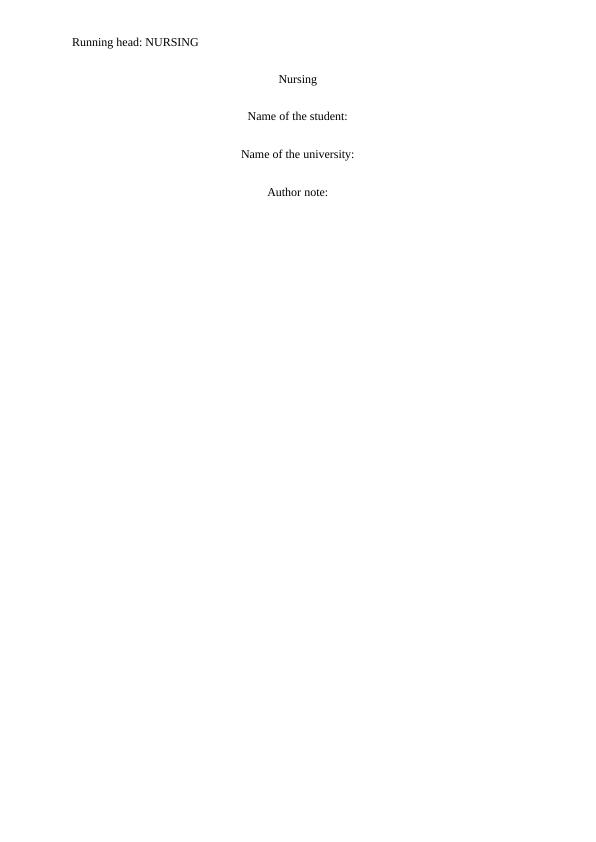Ask a question from expert
Nursing Research Paper | Assignment
12 Pages3154 Words259 Views
Added on 2019-11-25
Nursing Research Paper | Assignment
Added on 2019-11-25
BookmarkShareRelated Documents
Running head: NURSINGNursingName of the student:Name of the university:Author note:

1NURSINGIntroduction A critique of a research paper is a process of the systematic analysis of reviewing thepaper to discuss the strengths and weaknesses of the paper. A critique can be done for variouspurposes, such as to act as a reviewer who is an expert to assess that whether the researchpaper is authentic and will provide some comments on the work before the paper is beingsubmitted for publication. A critique underlines an indistinguishable component from anexploration plan and assesses how well the creator has done these components. The "to saythe very least" part is that, for finished research, a study likewise covers the informationinvestigation and whether that has been legitimately completed and deciphered. A study isn'treally 100 percent, or even any percent, basic (Amit, Mishali, Kotlovsky, Schwaber, &Carmeli, 2015). It might be transcendently positive. The following are a few things toconsider in setting up an evaluation. Not all will be appropriate for each examination papernor are you required to remark on every one of them for each paper. Rather concentrate onthings you distinguished as the most genuine potential issues or generally admirable. Summary Article 1: Facilitating central line–associated bloodstream infection prevention: Aqualitative study comparing perspectives of infection control professionals and frontlinestaff.Infection control professionals (ICPs) assume a basic part in executing and overseeingmedicinal services related disease lessening intercessions, through reducing the staffs thosewho are in charge of conveying immediate and progressing persistent care. The aim of thispaper was to decide whether ICPs and cutting edge staff have alternate points of view aboutthe facilitators and difficulties of focal line-related circulation system contamination(CLABSI) aversion program achievement (Barsuk et al., 2014). The researchers led the basic

2NURSINGsource interviews at 8 doctor's facilities that took part in the “Agency for Healthcare Researchand Quality CLABSI” anticipation activity called "On the CUSP: Stop BSI." We investigatedtalk with information from 26 ICPs and 50 frontline nurses to recognize regular subjectsidentified with the facilitators of program and difficulties. We recognized 4 facilitators ofCLABSI program achievement: instruction, authority, information, and consistency. It waslikewise distinguished into 3 normal difficulties: absence of assets, contending needs, anddoctor protection. Be that as it may, the point of view of ICPs and bleeding edge medicalattendants contrasted. Though ICPs tended to concentrate on general portrayals, forefrontstaff noted program specifics and regularly examined solid cases (Berenholtz et al., 2014).The outcomes recommend that ICPs need to consider the points of view of staff medicalattendants while executing disease control and more extensive quality change activities.Further, the think incorporation of bleeding edge staff in the usage of these projects might bebasic to program achievement.Article 2: Persistent nasal carriers of Acinetobacter Baumannii in long-term-carefacilitiesAcinetobacter Baumannii and Staphylococcus aureus have endured as 2 noteworthypathogens around the world. Liou et al. (2017) planned a predominance concentrate toresearch the pervasiveness of nasal carriage of S aureus and A. Baumannii in long haul mindoffices (LCTFs) and their collective group clinics. Likewise, we intended to illuminateconstant or non-persistent carriage of the 2 life forms among inhabitants of LTCFs. Theyresearchers played out a pervasiveness think about nasal bearers of A. Baumannii and Saureus in 3 LTCFs and 1 synergistic group healing centre. Seventy subjects were selected andbunched into 3 gatherings: the elderly debilitated gathering (n = 24), the elderly solidgathering (n = 33), and the sound social insurance labourer gathering (n = 13). Nasalexamples were gathered, and the nuc and mecA qualities of S aureus and the blaOXA quality

3NURSINGof a Baumannii were dissected by polymerase chain response. Among the 3 gatherings, therate of nasal carriage of S. aureus was around 0%-15% (Blot, Blot, S & Vandijck, 2014). Bethat as it may, the rate for A Baumannii was around 54%-92%. Eminently, the diligenttransporter rate of A. Baumannii in the elderly wiped out gathering was 83.3% (20 out of 24)in spite of a 12.5% (3 out of 24) rate of carbapenem-safe A. Baumannii. It was underlinedthat the constant nasal carriage of A Baumannii in LTCFs could be another entrance of exit tocause A Baumannii contamination in Taiwan.AcritiqueofBOTHresearch articlesBackground Article 1: Aim: The aim of this is to determine whether the ICPs along with the frontline stafftogether having some different thinking about the challenges and the facilitators of theprogram for the prevention of central-line associated blood stream infection. Background: A central line-associated bloodstream infection (CLABSI) can happenwhen a focal venous catheter, a strategy regularly connected with emergency unit settings,isn't embedded accurately or not looked after legitimately. CLABSIs result in criticalmonetary and nonfinancial expenses to wellbeing frameworks and society on the grounds thatsuch diseases increment danger of delayed hospitalizations, bleakness, and passing (Dotto etal., 2016). Luckily, the usage of institutionalized, prove based conventions can promptsensational and supported diminishments of CLABSIs in the ICUs of the hospital. Tool of data analysis: In this study the data were analysed by using the combinationof the deductive and the inductive methods. The transcripts and the notes taken from theinterviews of the study and is discussed as a preliminary findings of the study. After the

End of preview
Want to access all the pages? Upload your documents or become a member.